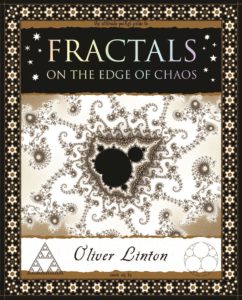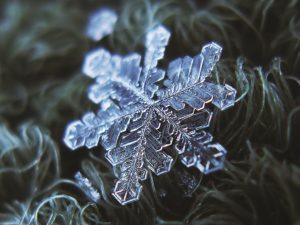I don’t know what I was expecting when I requested a reviewer’s copy of Oliver Linton’s Fractals: On the Edge of Chaos. The pocket-sized book, published in February, appeared to contain lots of lovely examples of shapes I associated with the etchings of Dutch artist M.C. Escher, such as staircases doubling in on themselves and frogs repeating into infinity.
Linton’s profile interested me as well. From his website, I learned that Linton is a retired physics teacher in the U.K. with a passion for travel, music, software, and early iron bridges. The publisher’s website described his book as appropriate “for anyone who has ever wanted to understand the patterns in leaves or the creation of snowflakes.”

By the fourth page, however, it became clear to me that, though I love leaves and snowflakes, I am not the “anyone” the publisher had in mind when they were targeting readers of Linton’s book. In an act of adolescent self-sabotage, I ate my bagged lunch through high-school geometry. I did not move up to calculus. Once in college, I enrolled in the fewest possible math and science courses, taking ones such as “The Physics of Music” (actually terrific) to fulfill distribution requirements. I never expected to feel regret, but there have been moments when I have wished I had learned more math. Holding Linton’s gorgeous little book was one of them.
Fractals are, as a general definition, shapes that repeat infinitely so that no matter how many times viewers zoom in, they are able to see the shape repeating again and again. Think ’60s op art or trippy computer screen savers that bend and pulse. But fractals also include shapes that aren’t so perfect. The field of “fractal geometry,” thought up by mathematician Benoit Mandelbrot in the 1970s, actually emerged as a way of understanding “roughness.”
“This book,” Linton writes, “attempts to describe the revolution in mathematics and art which followed.”
Linton wonders why so many structures found in the natural world are fractals. “One reason,” he writes, “is that fractals often arise spontaneously out of the repeated application of relatively simple rules. … Nature also uses fractals for reasons of economy … as fractal structures are often the most efficient way of performing a task, from a tree absorbing sunlight to a lung transferring oxygen to the blood.”
Linton explains that it is possible to represent such shapes in mathematical equations. Students of even basic geometry, such as I, know that numbers can describe and even predict shapes. I am aware, for example, that the area of a circle is πr2. But I don’t know how to use numbers to describe more complex shapes, especially ones that aren’t symmetrical or smooth, such as clouds or coastlines.
I understood Linton as he explained the first fractal, known as the “Koch snowflake.” But I struggled when he moved on to “Hausdorff dimensions,” a way of representing how fractals lie somewhere between the one-dimensional and two-dimensional. And then — just a few pages in — I was ready to give up. There was no way I was going to make it through an introduction and 28 chapters, albeit short ones, summarizing discoveries in fractal geometry. But I wanted to understand the math behind “Barnsley ferns,” “Julia sets,” and “Sierpiński triangles.”

Frustrated, I chatted with my daughter’s partner, Henry, an advanced software engineer with a lifelong love of math. When I showed him Fractals, he found it interesting but agreed that to truly understand the book, readers would need to remember all of high school math. Henry sent me — where else? — to YouTube, where I watched a video, “Fractals are typically not self-similar,” produced by the very brilliant ensemble known as 3Blue1Brown. After watching this 20-minute video twice, I did not emerge understanding all or even most of the math behind fractals. Henry told me, however, that it was enough to simply get the gist, and trust that the equations exist to describe so many complex shapes.
“I really like the complexity of mundane things, things you never think about,” he said. “It tickles me that some scientist has characterized snowflakes in Ph.D.-level detail. It’s just great. Maybe I don’t understand it, but I know that these are things that people can understand. The math doesn’t lie. And it is beautiful.”
I still cannot evaluate whether the history Linton presents is accurate, or whether his equations are sound. Meanwhile, the concepts behind fractal geometry have become clearer. I am able to appreciate a bit more of what Linton offers in Fractals. I can sit slowly with his explanation of “carpets and sponges,” for example, and let my mind expand to appreciate the mathematical representation of cells in the Scotch-Brite on my kitchen counter.



